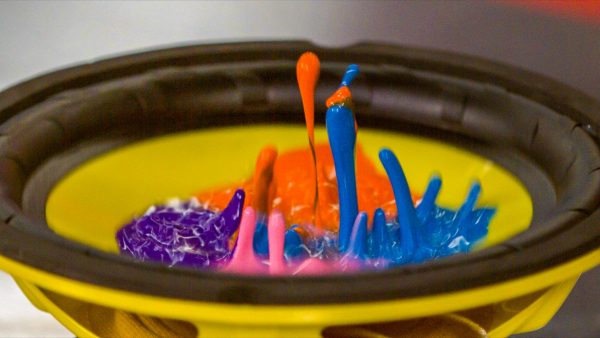Vibrating Definition
Vibrating is moving back and forth really fast. For example, a vibrating guitar string produces music.
View Lesson on Introduction to Sound
Become a member to get full access to our entire library of learning videos, reading material, quiz games, simple DIY activities & more.
Become a member to get full access to our entire library of learning videos, quiz games, & more.
Plans & Pricingto watch this full video.

Access All Videos
and Lessons, No Limits.
Access All Videos

No credit card required,
takes 7 sec to signup.
No card required

Ready-to-go lessons
that save you time.
Ready-to-go lessons
If you are on a school computer or network, ask your tech person to whitelist these URLs:
*.wistia.com, fast.wistia.com, fast.wistia.net, embedwistia-a.akamaihd.net
Sometimes a simple refresh solves this issue. If you need further help, contact us.
Introduction to Sound
Fun Facts
- A tuning fork in water shows visible vibrations.
- Vocal cords vibrate to create sound when humming.
- Loud speaker vibrations cause nearby objects to vibrate.
Why Do We Need To Know About Vibrating
Learning about vibrations helps us know how sound is made. Vibrations are key for talking, music, and using technology. This idea is used in making speakers, musical instruments, and tools for doctors to see inside your body.
Knowing about vibrations is useful in many careers like helping people with speech problems or inventing new gadgets that use sound. It’s all about making and changing sounds. This knowledge connects classroom learning with real-world uses, making it very useful for lots of different jobs.
Frequently Asked Questions
Check out the Full Lesson on Introduction to Sound
In this lesson, we learn that:
- We'll discover that when things vibrate they make sound.
- That sound can also make things vibrate.
- Vibrations are what let us hear each other speak.
Related Topics
- Bacteria Definition
- Bioindicator Definition
- Body Fossils Definition
- Chemical Change Definition
- Chemical Reaction Definition
- Chloroplast Definition
- Chloroplasts Definition
- Circulatory System Definition
- Classify Definition
- Definition Of Evidence
- Definition Of Human Body Systems
- Definition Of Shade
- Electromagnetic Spectrum Definition
- Environment Definition
- Exoskeleton Definition
- Fresh Water Definition
- Gas Definition
- Generator Definition
- Hearing Definition
- Landform Definition
- Light Definition
- Lunar Eclipse Definition
- Marsupial Definition
- Mineral Definition
- Mold Fossils Definition
- Multicellular Definition
- Mutation Definition
- Ocean Current Definition
- Paleontologist Definition
- Partial Eclipse Definition
- Photosynthesis Definition
- Physical Change Definition
- Pollution Definition
- Reflecting Surface Definition
- Renewable Resource Definition
- Reversible Change Definition
- River Definition
- Seismologist Definition
- Signal Definition
- Soil Definition
- Sound Definition
- Species Definition
- Tides Definition
- Vibrating Definition
- Watershed Definition
- Weather Map Definition
- Weathering Definition
- Wind Erosion Definition
Start a Free Trial Today. Get a $5 Amazon Gift Card!
Teachers! Start a free trial & we'll send your gift card within 1 day. Only cards left. Try it now.
Select Grade
Select Subject
This email is associated with a Science Kit subscription. Kit subscriptions are managed on this separate page: Manage Subscription

-
Download InvoiceScience & Math$/yr
-
Download InvoiceScience Only$/yr

access all lessons
• No credit card required •
"My students loved the videos. I started the video subscription in May and used them as a review before the state test, which I know contributed to 100% of my class passing the state test."
Rhonda Fox 4th Grade Teacher, Ocala, Florida
Use Generation Genius in Your School
Access all lessons free for 30 days.
"My students loved the videos. I started the video subscription in May and used them as a review before the state test, which I know contributed to 100% of my class passing the state test."
Rhonda Fox 4th Grade Teacher, Ocala, Florida
• No credit card required •
Already a member? Sign In
* no credit card required *

* no credit card required *
* no credit card required *


to Discover the Benefits of Generation Genius
Learn How to Save for Your School & District!

no credit card required
Skip, I will use a 3 day free trial
Enjoy your free 30 days trial
-
Unlimited access to our full library
of videos & lessons for grades K-5. -
You won’t be billed unless you keep your
account open past your 14-day free trial. -
You can cancel anytime in 1 click on the
manage account page or by emailing us.
-
Unlimited access to our full library of videos & lessons for grades K-5.
-
You won't be billed unless you keep your account open past 14 days.
-
You can cancel anytime in 1-click on the manage account page.
Cancel anytime in 1-click on the manage account page before the trial ends and you won't be charged.
Otherwise you will pay just $10 CAD/month for the service as long as your account is open.
Cancel anytime on the manage account page in 1-click and you won't be charged.
Otherwise you will pay $10 CAD/month for the service as long as your account is open.
We just sent you a confirmation email. Enjoy!
DoneWe use cookies to make your experience with this site better. By using this site you agree to our use of cookies. Click "Decline" to delete and block any non-essential cookies for this site on this specific property, device, and browser. Please read our privacy policy for more information on the cookies we use.Learn More
We use cookies to improve your experience. By using this site, you agree to our use of cookies. Click "Decline" to block non-essential cookies. See our privacy policy for details.Learn More




























































































































